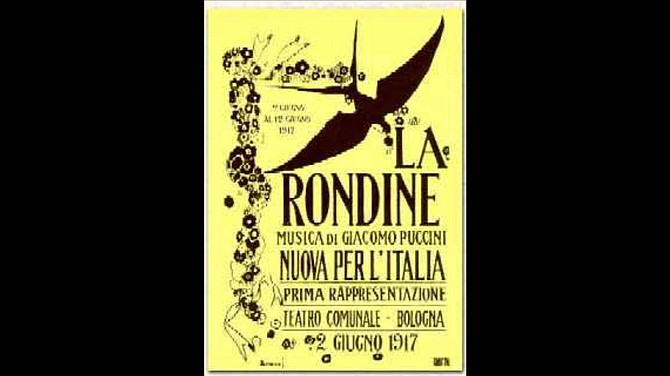 Facebook
Facebook
 X
X
 Instagram
Instagram
 TikTok
TikTok
 Youtube
Youtube

Ainhoa Arteta, Marcus Haddock, Inva Mula and Richard Troxell perfrom the the Act II brindisi ensemble from Puccini's La Rondine
Let’s connect some dots between Verdi and Puccini and Puccini and himself. This will only take a moment. The scene, which is an “other than arias” gem, is from Act II of Puccini’s La Rondine.
We can see similarities to the “toasting scenes” in Verdi’s La Traviata. In both scenes the young tenor begins by giving a toast to an older woman. This is very much a 19th-century pick-up line.
Both these stories are centered around an autumn and spring relationship between what we now call a cougar and her cub. Ruggero and Magda, in La Rondine, have the same type of relationship as Alfredo and Violetta in Traviata.
There is a distinction to be made between Magda who is a married woman of the upper middle class and Violetta who is a courtesan. A courtesan isn’t exactly a prostitute but more of what we would call a “kept woman.”
When it comes to the style of the music, Verdi’s brindisi is full of bubbling champagne, while Puccini drowns us in Kahlua and cream.
The second act of La Rondine also resembles Puccini’s own second act of La Boheme. The ensemble here in Rondine is reminiscent of the ensemble at the conclusion of Musetta's Quando me’n vo’.
Both scenes take place in a Parisian establishments of less than stellar repute. In Boheme it’s the appropriately bohemian Cafe Momus and in Rondine it is the working class ballroom of Builler’s.
Both Boheme and Rondine incorporate the beta-couple into the scene. In Boheme that would be Musetta and Marcello. In Rondine it is Prunier and Magda’s maid Lisette.
I think it is clear that Puccini isn’t breaking new ground here, but I care not. The lyrical rise and fall of this music creates an atmosphere of growing desire. The aroma of flowering sexuality drips off of each phrase.
In many productions and indeed in the score itself, the chorus is directed to shower the couples with flower petals as they sing/scream “with flowers” — coi fior on high B flats.
It’s not Puccini’s subtlest moment, but that’s probably while I like it so much.


Ainhoa Arteta, Marcus Haddock, Inva Mula and Richard Troxell perfrom the the Act II brindisi ensemble from Puccini's La Rondine
Let’s connect some dots between Verdi and Puccini and Puccini and himself. This will only take a moment. The scene, which is an “other than arias” gem, is from Act II of Puccini’s La Rondine.
We can see similarities to the “toasting scenes” in Verdi’s La Traviata. In both scenes the young tenor begins by giving a toast to an older woman. This is very much a 19th-century pick-up line.
Both these stories are centered around an autumn and spring relationship between what we now call a cougar and her cub. Ruggero and Magda, in La Rondine, have the same type of relationship as Alfredo and Violetta in Traviata.
There is a distinction to be made between Magda who is a married woman of the upper middle class and Violetta who is a courtesan. A courtesan isn’t exactly a prostitute but more of what we would call a “kept woman.”
When it comes to the style of the music, Verdi’s brindisi is full of bubbling champagne, while Puccini drowns us in Kahlua and cream.
The second act of La Rondine also resembles Puccini’s own second act of La Boheme. The ensemble here in Rondine is reminiscent of the ensemble at the conclusion of Musetta's Quando me’n vo’.
Both scenes take place in a Parisian establishments of less than stellar repute. In Boheme it’s the appropriately bohemian Cafe Momus and in Rondine it is the working class ballroom of Builler’s.
Both Boheme and Rondine incorporate the beta-couple into the scene. In Boheme that would be Musetta and Marcello. In Rondine it is Prunier and Magda’s maid Lisette.
I think it is clear that Puccini isn’t breaking new ground here, but I care not. The lyrical rise and fall of this music creates an atmosphere of growing desire. The aroma of flowering sexuality drips off of each phrase.
In many productions and indeed in the score itself, the chorus is directed to shower the couples with flower petals as they sing/scream “with flowers” — coi fior on high B flats.
It’s not Puccini’s subtlest moment, but that’s probably while I like it so much.
Comments